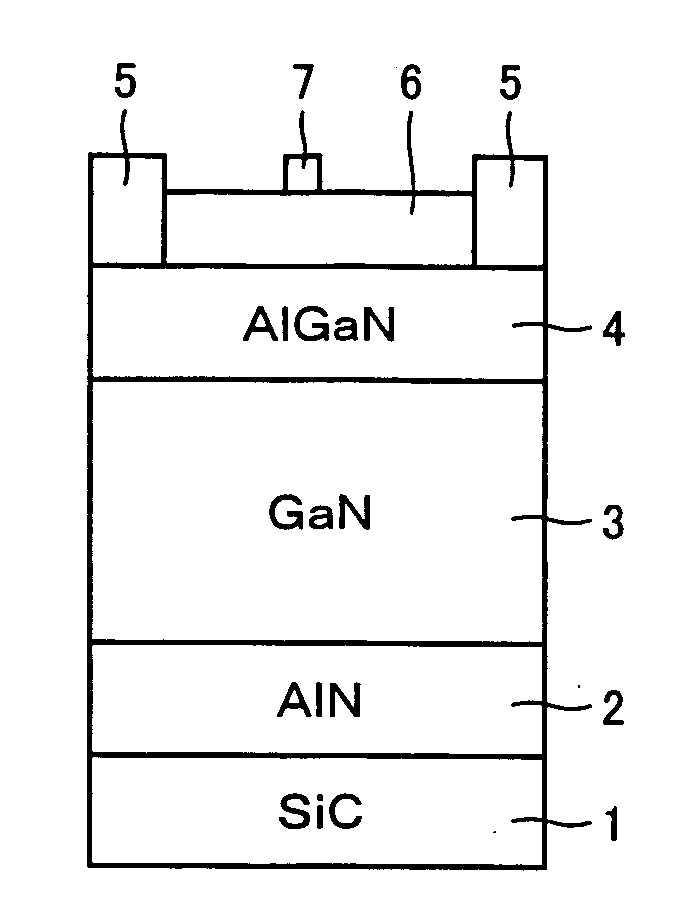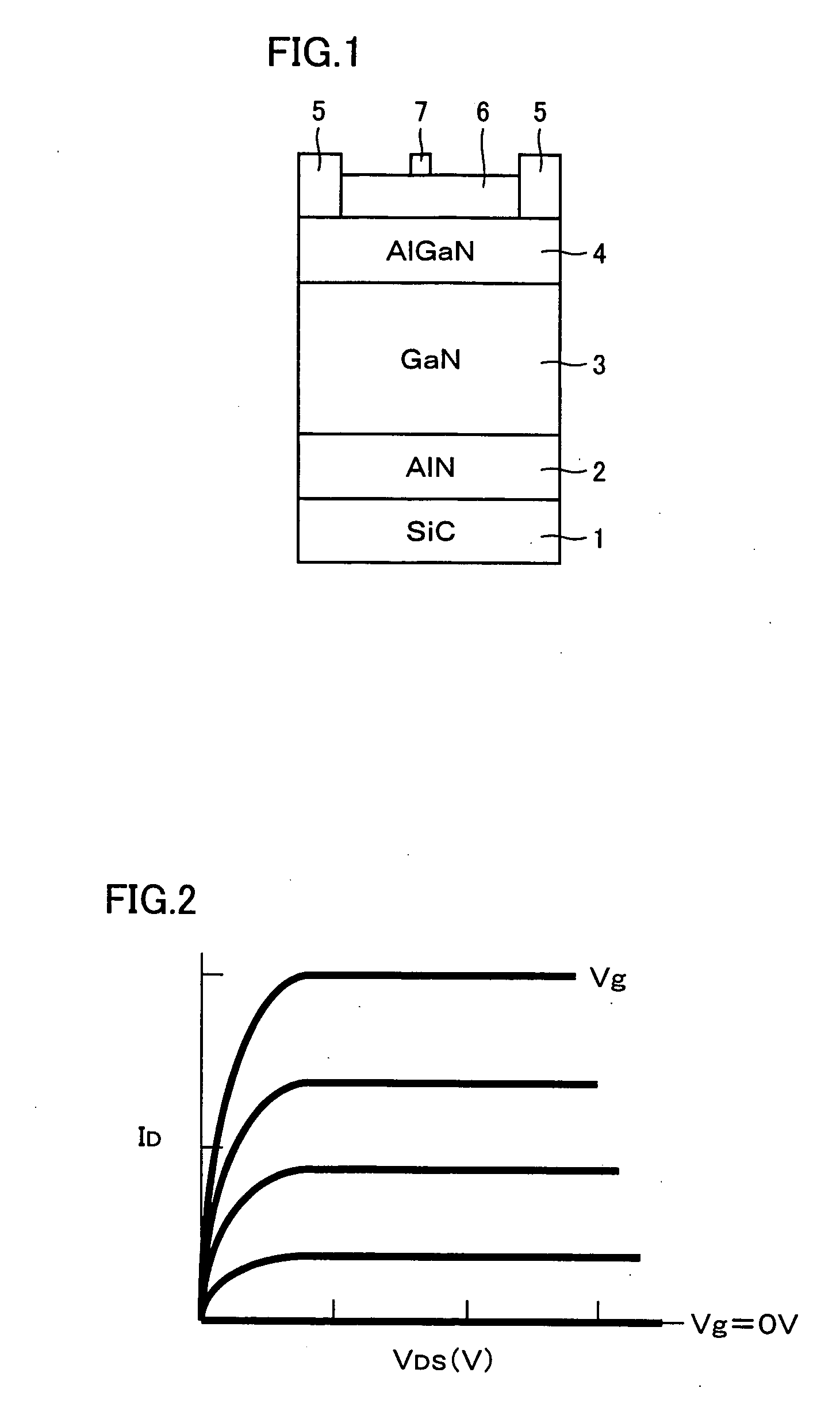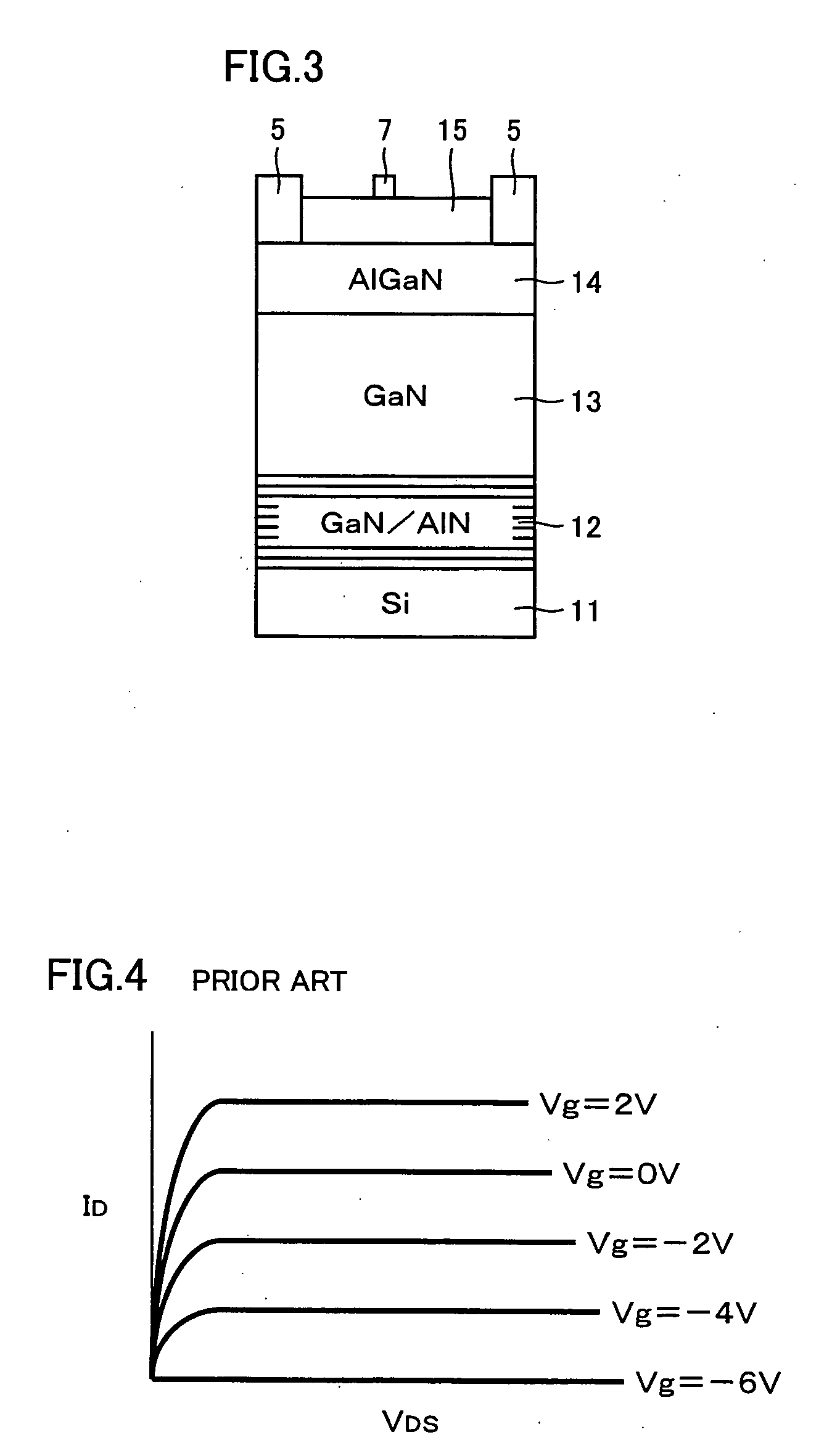Field-effect transistor
a field-effect transistor and transistor technology, applied in the direction of transistors, electrical devices, semiconductor devices, etc., can solve the problems of difficult to form a high-quality p-type layer, the transistor itself breaks down, and the difficulty of forming an n-type region within a p-type layer
- Summary
- Abstract
- Description
- Claims
- Application Information
AI Technical Summary
Problems solved by technology
Method used
Image
Examples
embodiment 1
[0037]FIG. 1 is a schematic sectional view showing a hetero-junction FET according to Embodiment 1 of the present invention. In order to prepare this FET, an AlN buffer layer 2 having a thickness of 20 nm is grown on an Si atomic plane of an SiC substrate 1 by MOCVD (metal organic chemical vapor deposition) at a substrate temperature of 1200° C. Then, a GaN channel layer 3 having a lattice constant a=3.189 Å and a band gap Eg=3.42 eV is grown to a thickness of 3 μm on AlN buffer layer 2 at a substrate temperature of 1100° C. Then, an Al0.3Ga0.7N barrier layer 4 having a lattice constant a=3.166 Å and a band gap Eg=4.02 eV is grown to a thickness of 20 nm on GaN channel layer 3 at a substrate temperature of 1100° C.
[0038] Thereafter, in order to form source and drain electrodes 5a, a resist film is patterned by photolithography; a multilayer metal film is deposited including Hf (10 nm thickness) / Al(100 nm thickness) / Hf(40 nm thickness) / Au(240 nm thickness) layers stacked in this ord...
embodiment 2
[0040]FIG. 3 is a schematic sectional view showing a structure of an FET including a hetero-structure according to Embodiment 2 of the present invention. In this FET, an Si substrate 11 is used for depositing an AlN / GaN multilayer film as a buffer layer 12, growing a GaN layer of 1 μm thickness having a lattice constant a=3.189 Å and a band gap Eg=3.42 eV as a channel layer 13 at a substrate temperature of 1000° C., and growing an Al0.2Ga0.8N layer of 30 nm thickness having a lattice constant a=3.174 Å and a band gap Eg=3.80 eV as a barrier layer 14 at a substrate temperature of 1100° C. When an AlN layer or a GaN layer is grown on Si substrate 11, an Al atomic plane or a Ga atomic plane appears on its upper surface (the side on which electrodes are to be formed).
[0041] An oxide film or a fluoride film serving as a piezoelectric effect film 15 can be deposited by sputtering also in Embodiment 2, similarly as in the case of Example 1. The sputtering can be carried out by using Ar an...
embodiment 3
[0043]FIG. 7 is a schematic sectional view showing a structure of an FET including a hetero-structure according to Embodiment 3 of the present invention. While the GaN layer and the AlGaN barrier layer are so stacked that a Ga atomic plane of each of the layers appears on the upper surface (the side on which electrodes are to be formed) in each of the aforementioned Embodiments 1 and 2, a GaN layer 13 and an AlGaN layer 14 can alternatively be so stacked that an N atomic plane of each of the layers appears on the upper surfaces (the side on which electrodes are to be formed) as in this Embodiment 3.
[0044] In this case, a buffer layer 12 of AlN, a first semiconductor layer 14 of AlGaN and a second semiconductor layer 13 of GaN are stacked in this order on a C atomic plane of an SiC substrate 11, as shown in FIG. 7. At this time, AlGaN layer 14 and GaN layer 13 have their respective lattice constants a1 and a2 in the relation a12 (i.e., the lattice constant a1 of AlGaN is reduced bel...
PUM
 Login to View More
Login to View More Abstract
Description
Claims
Application Information
 Login to View More
Login to View More - R&D
- Intellectual Property
- Life Sciences
- Materials
- Tech Scout
- Unparalleled Data Quality
- Higher Quality Content
- 60% Fewer Hallucinations
Browse by: Latest US Patents, China's latest patents, Technical Efficacy Thesaurus, Application Domain, Technology Topic, Popular Technical Reports.
© 2025 PatSnap. All rights reserved.Legal|Privacy policy|Modern Slavery Act Transparency Statement|Sitemap|About US| Contact US: help@patsnap.com



